This is a republishing of an article that first appeared on FABDB in October 2020. Hayden Dale is the winner of the 2019 Calling in Sydney. Originally from New Zealand, he now calls Australia home. Instantly hooked by the game, Hayden has a huge interest in the competitive side of Flesh and Blood. You can find him on Facebook under Hayden Dale, or over on Instagram @gaming_instyle .
Crucible of War had been with us for just over a month; the inaugural New Zealand Nationals had given us our first high-level results. The first Nationals was dominated by the established big meta players of the Classic Constructed format: Mechanologist, Warrior, and Ninja. Mixed in there were strong showings of Brute and Guardian. Runeblade, Wizard and Ranger were the three lowest played classes- which was expected, in large part due to how short a window players had to test and work out the classes.
For me personally, I spent the last 4 weeks testing with a 3-person team of friends in support of them heading to New Zealand Nationals. As we tried to thoroughly explore every hero, every strategy, and every configuration of 80 cards that might get them to the top, I saw firsthand just how big the mountain was. Time really was just too limited. Consequently, we quickly put aside the classes and strategies that we felt needed the most investment, or that ran the greatest risk of giving us no gains on the time we spent on them.
Ranger was the first to fall victim, followed by Guardian, then Wizard and Warrior (the latter due to the way in which we knew we wanted to attack the expected meta for the event). Ultimately we would land on a Brute build that looked to explode with consistency to land substantial damage turns by way of Mandible Claws, Art of War and Bloodrush Bellows.
So what does my experience in testing for Nationals have to do with Azalea? The Ranger class is one I was pretty keen on delving into more, so once the pressure of Nationals passed, I turned my attention back to Azalea. But while building Ranger is the format, it's certainly not my sole focus here. In this series, I won't just showcase Azalea and the Ranger class. I want to use these articles as an opportunity to expand upon the journey, on my experience of learning, testing, tuning, and developing the decklist over the course of weeks and months.
Here, I'll be sharing how I approach deck building, developing game plans for decks/heroes, and how I test and adapt my overall build as I go through my process. I hope this can be helpful not just for those interested in Azalea, but also anyone looking to develop or improve on the way in which they approach deck building and testing decks in Flesh and Blood.
The Building Blocks of a Ranger
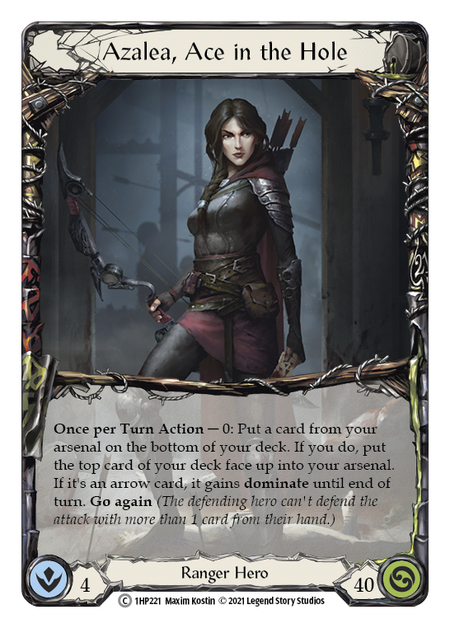
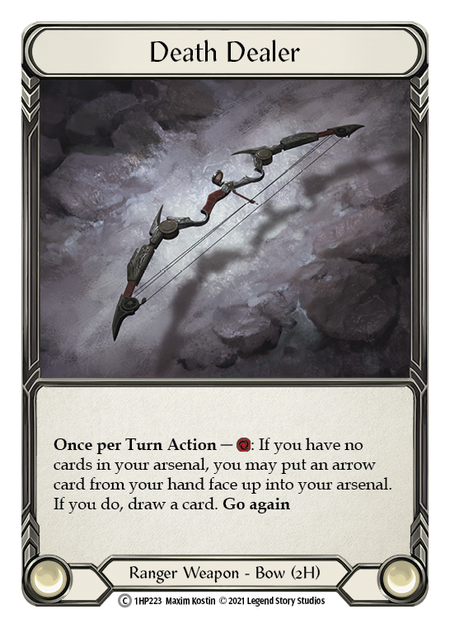
Whenever I look to build a new deck for whatever reason, be it for a big event such as Nationals or just to take for a spin down at Armory events, I will always begin with a clear focus for the build. This could be one, two, three or even more specific focuses, such as:
- To attack the meta in a specific way
- To beat or counter a specific deck, hero, or archetype
- To take advantage of a strong set of cards or specific interaction
- To fit into a game plan mold (aggro, midrange, control, fatigue, etc.)
- To utilize a specific hero or specific cards
- To pull off a specific combo
Your focus could really be anything. However, for this build, my primary focus is simply to play Azalea! The second focus will be to target two of the top dogs in the Classic Constructed meta: midrange Dash and Brute. The third focus is to look to take advantage of powerful interactions with Azalea’s hero power and her very unique weapon, Death Dealer.
Starting a Deck
So where to start? Which cards go into our deck for testing, tuning and exploring Azalea? With every deck, I will always start by building a core to the deck that will be responsible for executing my main game plan. Generally I will always play this full core in every match-up, shifting in and out utility pieces depending on the match-up. The core should be a well oiled machine by the time I finish testing and tuning the list. I generally see the core of a deck to be around 40 to 50 cards, however this can certainly vary depending on how many cards you've included for specific match-ups, and whether you want to utilize the full deck capacity.
In this instance, I have started with a core that is 56 cards. Part of the game plan is built on leveraging the power of Death Dealer. Because Death Dealer replaces the arrow card you drop into Arsenal, it allows us to present hands that can both block efficiently with 1 to 3 cards and still return fire on our turn.
I generally see the core of a deck to be around 40 to 50 cards.
Tying into the second focus of targeting specific match-ups, I began with the idea of being able to maximize strong 5 card hands to regularly present 2 to 3 attacks that carry powerful 'on hit' effects (a trademark of the Ranger's repertoire). This would apply pressure to the opponent and force cards out of their hand. Applying consistent pressure, and leaking damage over time, can go a long way in both the Dash and Brute match-ups, keeping them from executing their own game plans effectively. Azalea’s hero ability also plays well here: adding Dominate to one of our attacks ensures that it is very difficult for our opponent to avoid letting damage (and those disruptive 'on hit' effects) through.
Because most of our arrows have 'on hit' effects, these 2 or 3 card attacks can cause our opponents to have real issues playing back at us on their next turn. Cards like Red in the Ledger, Hamstring Shot, and Promise of Plenty all help us present multiple attacks on a turn that are nearly must-block. Since Brute is also a focus for us, being able to efficiently use our 5 cards on any turn in important to minimize the impact of Intimidate.

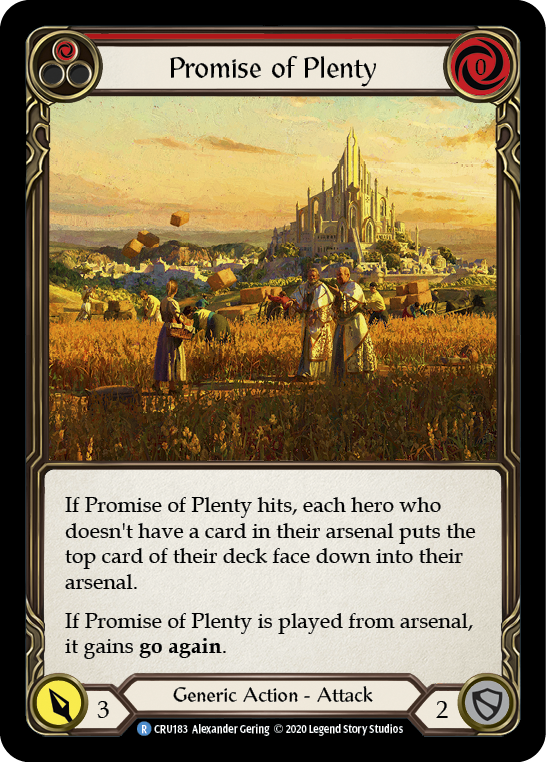
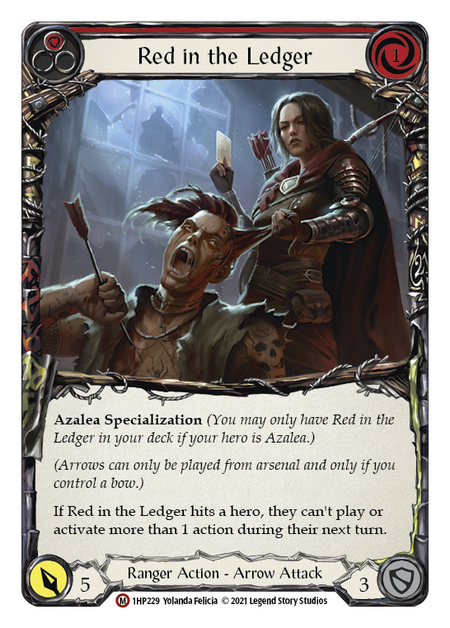
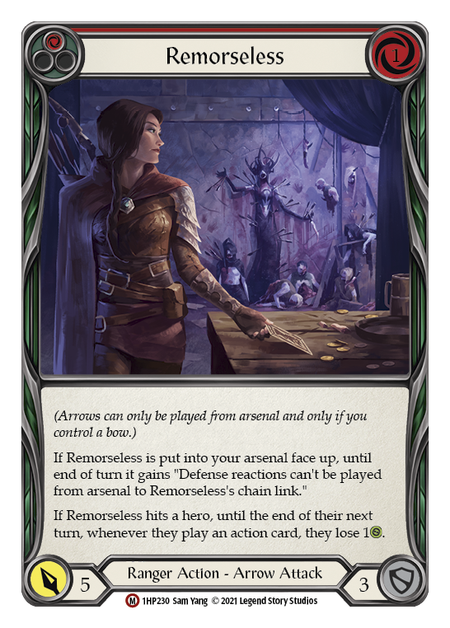
Here's my first iteration of the deck:
Weapons
Equipment
Red
- Endless Arrow (3)
- Flock of the Feather Walkers (3)
- Hamstring Shot (3)
- Head Shot (3)
- Promise of Plenty (3)
- Razor Reflex (3)
- Red in the Ledger (3)
- Remorseless (3)
- Ridge Rider Shot (3)
- Searing Shot (3)
- Sic ‘Em Shot (3)
- Sleep Dart (3)
- Take Aim (3)
- Three of a Kind (2)
Yellow
Blue
Sideboard
This gives us a core of 56 cards and a sideboard/utility package of 19 cards. The bulk of these 19 cards- Tripwire Trap, Take Cover, and Feign Death- allow us to bring in some defensive options vs. Warrior, Ninja, and the unlikely mirror match- the latter being a solid card for the Runeblade match-up also (I would not play Feign Death in the mirror however). Eirina’s Prayer is for the raw power of Kano. The rest of my sideboard consists of a third copy of Three of a Kind, 3 copies of Art of War, and 3 Enlightened Strikes; these allow us to maximise a go wide strategy and present 2 to 3 attacks a turn. I would play all of these against our two focus match-ups- Dash and Brute- leaving out the defensive suite altogether.
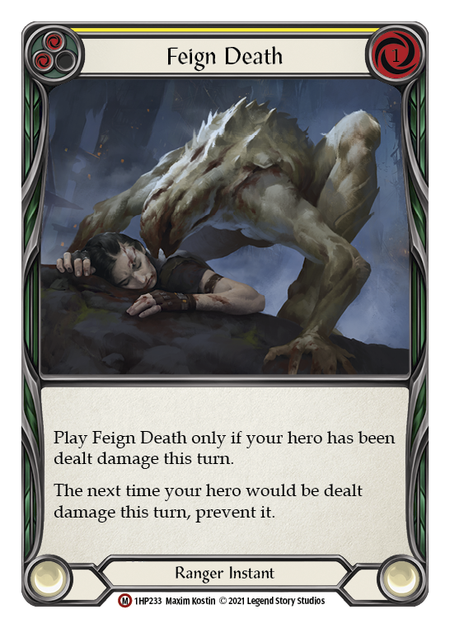
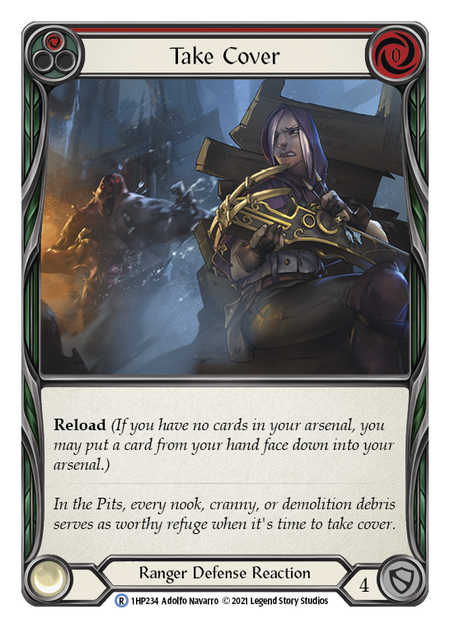
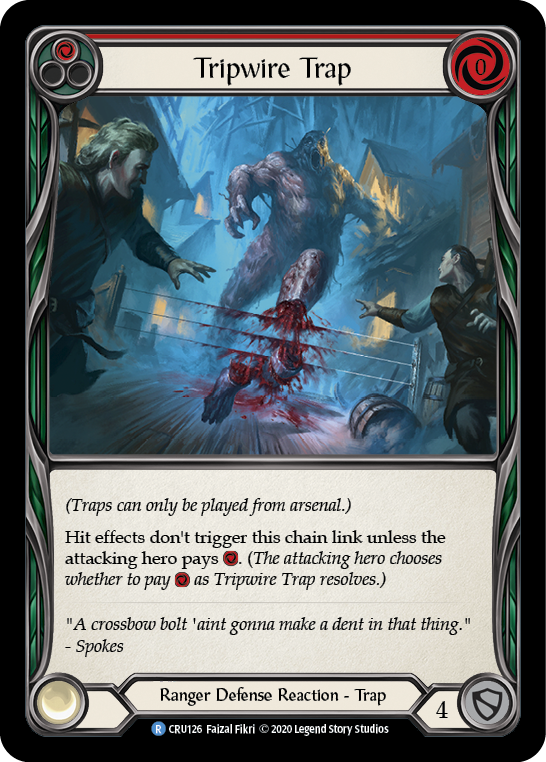
The core is focused heavily on a mix of cards that set us up and allow us to maximise multiple attacks (Flock, Promise, Sic ‘em, Rapid Fire), allow us to reload and augment our arrows (Take Aim and Razor Reflex), and of course, the arrows themselves. It is worth pointing out that I would consider cutting some arrows in certain matchups where the 'on hit' effect is not relevant: Sleep Dart vs. Dash, for example, or Hamstring Shot vs. Kano. My initial approach will be keeping close to a 60 card deck to maximise the aggressive combo of multiple attacks each turn. Keeping to 60 cards ensures we draw our best cards and avoid filler. I do have some concerns around being fatigued by our opponents and running out of cards, so I may revisit this plan in the future. Fatigue is a real threat when you don’t have a weapon to attack with; cards truly are an important resource in this game.
There are certainly some other cards I have an eye on and want to test in this build. However, some of these cards I also think are less likely to make the cut due to either overall power level or not being conducive to the overall game plan. Notable omissions in the current build include Nimblism and Nimble Strike, Plunder Run, Scar for a Scar, Ravenous Rabble, Pathing Helix, Poison the Tips, and Increase the Tension.
Winning with Azalea
Whenever I play test a new concept or deck, I always make sure to have a sturdy conceptual idea of the game plan: how I'm going to play out turns and, ultimately, how I will win the game. (I can’t stress enough the importance of this concept. You need to know what you are working towards at the end of a game!)
With our Azalea build, I know I want to keep the life totals and the game close while working my opponent down to below 20 life. Simultaneously, I want to make sure I am pitching and setting up cards that will allow me to go wide and present turns that guarantee leaked damage late game (Take Aim, Art of War, Three of a Kind, Razor Reflex, Head Shot, Rapid Fire). I don’t need every copy of all of these cards, but I need enough density of some of these cards. I need to guarantee I can string back to back to back turns and present guaranteed damage in combination with some relevant 'on hit' effects, to prevent the opponent from picking their spot and turning the tempo by just taking the damage on one turn. The later the game goes, the more consistent we want our remaining deck to be.
Match-Ups, Learning, and Tuning a Deck
So that’s our week one Azalea build, with a bit of context around card choice, gameplan design, and some information on how I approach deck building in Flesh and Blood. In the next part of the series, I will delve into specific match-ups and go in depth on how to play the deck. I will also share a lot of my own learning as I go, the ups and downs, and what I really think about Azalea's chances as a competitive force post-CRU. My plan is to tune the deck as I go and share ‘the what and the why’.
I would also like to make this interactive! If you have any questions for me, either on Azalea specifically or on anything related to deckbuilding and the process of refining builds, please leave a comment or shoot me a message on Facebook or Instagram and I will do my best to incorporate it. Working on Azalea yourself? Leave a comment and let us all know which cards you love (or which cards you don’t) and why!
In part 2 of this 4-part series, Hayden returns with Azalea in tow, after a few weeks of testing and with some fresh ideas.
by: Hayden Dale





